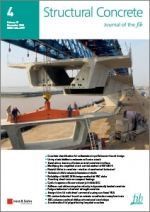Structural Concrete 04/16
Taken from the technical paper On the reliability of the design approach for FRC structures according to fib Model Code 2010: the case of elevated slabs
by Marco di Prisco, Paolo Martinelli, Benoit Parmentier.
"[...] Steel fibre-reinforced concrete (SFRC) is a well-known construction material that has been used quite extensively to build industrial pavements, harbour and airport pavements, shotcrete linings, tunnel segments, precast sewer pipes, retaining structures, foundation slabs, slabs on piles and elevated slabs supported on columns. The use of SFRC in these structures is particularly convenient because it gains advantages from the redundancy of these structures. It also allows significant reinforcement optimizations in terms of casting simplification, a performance increase such as depth reduction, quality of the casting and durability due to crack opening control.
 This paper focuses on the reliability of the design approach proposed in the fib Model Code for Concrete Structures 2010 for estimating the ultimate capacity of fibre-reinforced concrete (FRC) elevated slabs on the basis of different tests for material characterization. The fracture properties of the material are determined through three-point bending tests on notched beams and through double edge wedge splitting (DEWS) tests carried out on cylinders cored in the full-size test structure. As a case study, an FRC elevated flat slab 0.2 m thick is considered which consists of nine bays (panels) measuring 6 × 6 m (overall size 18.3 × 18.3 m) and is supported by 16 circular concrete columns. The ultimate bearing capacity of the slab determined experimentally is compared with the design value predicted by means of a procedure based on limit analysis following fib Model Code 2010. The results show that the method proposed in fib Model Code 2010 using the characteristic values and the classification is reliable. Even if the tests are affected by a significant standard deviation and the two experimental campaigns with three-point bending tests give a significant difference between class ”5c“ and class ”3e“, the structural test results in a loadbearing capacity that is always larger than the predicted one, which considers a safety coefficient for the material γF = 1.5.[...]"
This paper focuses on the reliability of the design approach proposed in the fib Model Code for Concrete Structures 2010 for estimating the ultimate capacity of fibre-reinforced concrete (FRC) elevated slabs on the basis of different tests for material characterization. The fracture properties of the material are determined through three-point bending tests on notched beams and through double edge wedge splitting (DEWS) tests carried out on cylinders cored in the full-size test structure. As a case study, an FRC elevated flat slab 0.2 m thick is considered which consists of nine bays (panels) measuring 6 × 6 m (overall size 18.3 × 18.3 m) and is supported by 16 circular concrete columns. The ultimate bearing capacity of the slab determined experimentally is compared with the design value predicted by means of a procedure based on limit analysis following fib Model Code 2010. The results show that the method proposed in fib Model Code 2010 using the characteristic values and the classification is reliable. Even if the tests are affected by a significant standard deviation and the two experimental campaigns with three-point bending tests give a significant difference between class ”5c“ and class ”3e“, the structural test results in a loadbearing capacity that is always larger than the predicted one, which considers a safety coefficient for the material γF = 1.5.[...]"
The full article is available online for free until December 31st, 2016. Contiune reading on WileyOnlineLibrary.
P.S. If you are interested in more free content, sign up for our monthly newsletter. We regularly feature articles from our journals.


